The Number of Hoosier Businesses Is Shrinking
Most discussions of the economy are built around employment, but there are other ways of looking at progress and decline. The number of firms in business may be another of these measures because it might indicate something about the business climate and the entrepreneurial spirit of the area.
Between 1998 and 2001, the last full year for which we have data for all states from the U.S. Census Bureau, Indiana lost 617 business establishments. That is a net figure. Some businesses were born while others died. On balance, we had a decline of 0.4 percent. That does not sound like much of a loss until it is compared with the nation’s growth of 2.2 percent during the same period.
Only five states had greater percentage losses than Indiana. Only 10 states suffered any loss at all (see Figure 1).
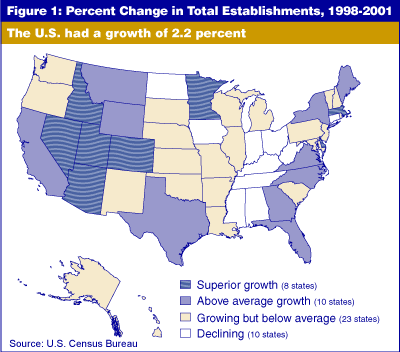
Business formation is believed to be one indicator of a state’s economic vitality. New businesses are generally small in terms of the number of employees they have. In 2001, Indiana had more than 71,700 establishments with fewer than five employees (see Figure 2). They accounted for 49.3 percent of the state’s 145,600 establishments, compared with 53.8 percent in that size class nationally. That puts us in 49th place among the states. If small firms are the key to business development, then this is a troublesome figure.
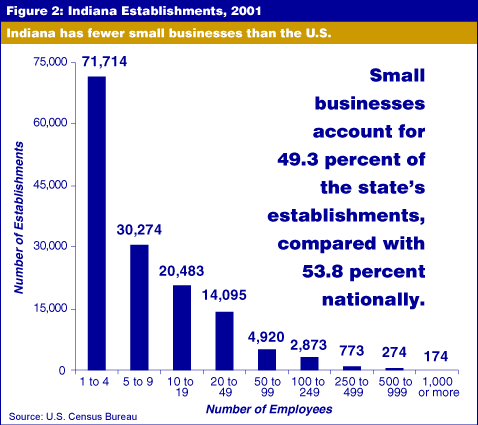
But are small businesses the kindling wood of economic progress? Montana, New York, Florida and Wyoming are the leaders in the percent of establishments with fewer than five employees. Their economic fortunes are very diverse and it would seem a flimsy argument to hang the idea of growth on the number or change in small businesses. We may have fewer small businesses reporting their existence to the state. Could it be lax administration of the tax code by Indiana that leads to this statistical artifact?
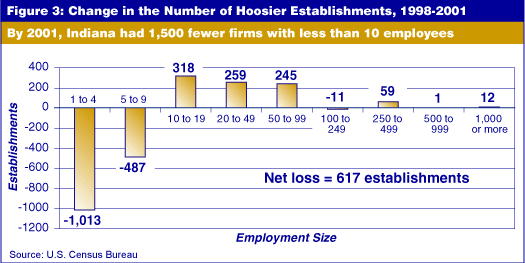
Figure 3 shows that Indiana’s losses between 1998 and 2001 were mainly
in the number of small establishments. In 2001, Indiana had 1,500 fewer firms
with less than ten employees than it had in 1998. Some of the small firms
may have grown, but again, on balance we had fewer firms in 2001 than three
years earlier.
Nationally, as seen in Figure 4, firms of all sizes were growing during
these years. So we cannot say that our difficulties were just reflective
of the nation’s problems.
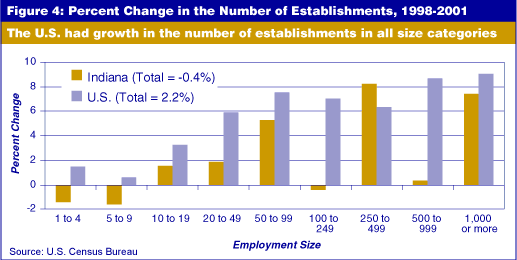
Where Was the Growth?
The government provides data on 21 industry groups. The nation grew in 17 of these 21 industries; Indiana grew in just 13 (see Table 1). Indiana outperformed the nation in four industries, including manufacturing. (Actually, our -2.7 percent decline in manufacturing was less than the nation’s -3.7 percent, hence we can say Indiana “outperformed” the nation.)
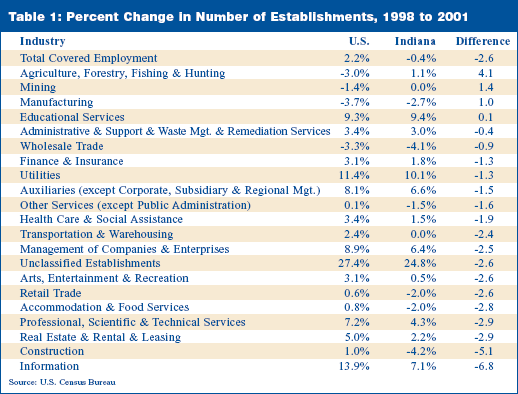
Three of the four industries in which Indiana did outperform the nation were declining nationally. Only education services was a high growth activity and there we beat the nation by a scant 0.1 percent, hardly an achievement to crow about.
Our greatest deficit in growth (-6.8 percent behind the nation) was the information sector. This includes telephone, cable and other communication services, plus newspapers and publishing. Where the nation advanced by 13.9 percent, Indiana managed a 7.1 percent increase.
Does the number of businesses count? If innovation and flexibility are related to the number of enterprises, then it is important. Presumably, a story can be told to make that link. The more firms in an industry, the more different views exist on how to make a profit. But is there any evidence to support the idea that there are greater profits, higher wages or more enduring employment in places with large numbers of small- or medium-sized firms? It is part of our economic mythology, but is it part of our economic reality?
Morton J. Marcus
Director Emeritus, Indiana Business Research Center,
Kelley School of Business, Indiana University
